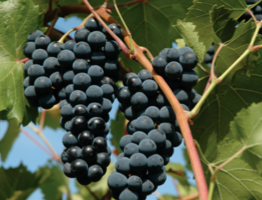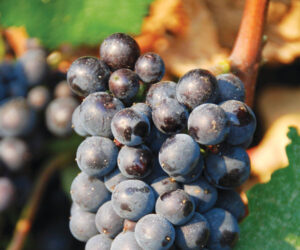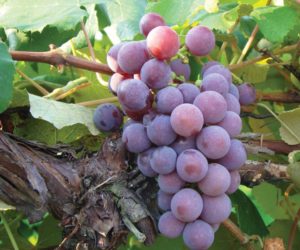 For most of my life I have enjoyed the relatively mild Mediterranean climate we experience here in California. However, I grew up in Crystal Lake, Illinois, about 50 miles northwest of Chicago. At the time, it was a tiny farm town, population about 8,000. Crystal Lake was a great place to grow up; there were ponds, lakes, open woodlands, and winter play. Winter play equals cold, which is something I experienced a lot as a child. I don’t envy the majority of the North American continent this past year. Months of winter gets old real fast. For grapes, specifically Vitis vinifera, adapting to cold is something that takes some help. Giving “help” to traditional wine grape varieties requires time; and time requires money. And thus, growers look at alternatives to planting the traditional wine grape varieties. Enter the hybrids — specifically, Marquette.
For most of my life I have enjoyed the relatively mild Mediterranean climate we experience here in California. However, I grew up in Crystal Lake, Illinois, about 50 miles northwest of Chicago. At the time, it was a tiny farm town, population about 8,000. Crystal Lake was a great place to grow up; there were ponds, lakes, open woodlands, and winter play. Winter play equals cold, which is something I experienced a lot as a child. I don’t envy the majority of the North American continent this past year. Months of winter gets old real fast. For grapes, specifically Vitis vinifera, adapting to cold is something that takes some help. Giving “help” to traditional wine grape varieties requires time; and time requires money. And thus, growers look at alternatives to planting the traditional wine grape varieties. Enter the hybrids — specifically, Marquette.
Marquette is a red grape that was developed at University of Minnesota, which operates an active breeding program for varieties that are both cold-tolerant and disease-resistant. The breeders were Peter Hemstad and James Luby, the same men responsible for creating La Crescent. They created Marquette as a cross between MN1094 and Ravat 262. It is a cousin of Frontenac and a grandson of Pinot Noir. I found some conflicting information on when the cross was actually made, the Iowa Sate University website lists the creation of Marquette in 1989, but the details filed with the United Sates Patent Office list that it was “discovered in vineyard block 1 row 20 of the University of Minnesota’s Horticultural Research Station in 1997.” Both explanations are plausible in that the seedling was planted in 1997 and after having survived a few cold winters outdoors it was determined worthy of being worked up for other resistive traits. In either case, the variety was released in 2006. MN1094 is a complex cross of V. vinifera, V. riparia and other Vitis species. These breeders hit the lottery of desirable traits in that Marquette has shown good resistance to downy mildew (Plasmopara viticola), powdery mildew (Uncinula necator) and black rot (Guignardia bidwellii). It is somewhat susceptible to foliar phylloxera, but that can be remedied with a well-timed spray program.
As I write this article, I am actually multitasking. I am taking breaks in between wines for a tasting of hybrids that are part of a breeding program here at UC-Davis. I have known this for a long time, but just now, this instant, I get this feeling of awe and accomplishment at what goes into developing hybrid grape species, and I am part of it. We don’t do cold-hardy breeding here in California, but grape breeders are faced with the same challenges of what it actually takes to get a vine to the market. Grape breeders are dealing with thousands of seedlings in both greenhouse and field trials. There is also a research laboratory component to the breeding program to determine if the genetic markers are present that give the plants their resistance. To do this, strict criteria must be met to confirm the pathogen can cause the disease and, when disease symptoms are seen, the pathogen can be isolated from the affected plant.
On top of all the research that goes into hybrid development are the logistics of licensing, marketing, and actually selling the plant. The grape is essentially the “intellectual property” of University of Minnesota. The variety was patented under US patent number PP19579 assigned to the Regents of the University of Minnesota. To propagate and grow just one plant of Marquette requires a license that can be obtained through the University of Minnesota. The license fee ($200) allows you to propagate and sell Marquette in the United States and Canada. For each plant sold, the licensee must pay an additional 50 cents per plant as a royalty. There are several nurseries that carry the variety and there is a high demand for it. Interestingly, Nova Vine, in Santa Rosa, California, has a license to propagate, piquing my curiosity as to how it would do in our vineyards at UC-Davis. You never know, it might be worth a couple of test rows.
Of course, the main objective in the breeding program is the resistance trait(s) that are being selected for, but we as winemakers have another trait to select for, and that is how good is the wine that is made from the fruit. As part of my job, I have the privilege of doing just that. Our breeding program focuses on disease resistance to the aforementioned diseases minus black rot. The research group essentially delivers anywhere from 25 to 100 pounds of fruit to the winery with only one request — make the best wine possible. This is small-scale winemaking at its best. Every detail with respect to temperature control, mixing, and sanitation are crucial, as one mistake could be the end of the line for that plant. We do not always base the “cut” on one year’s winemaking results, but we do learn a lot in that year about the cross.
Under the conditions that Marquette was developed, it withstood temperatures as low as -36 °F (-38 °C), but overwintered in an area where it was routinely exposed to temperatures around -20 °F (-29 °C). Marquette is reported to have borne a full crop when exposed to temperatures below -30 °F (-34 °C), but you cannot give an absolute number as to how the plant tolerates the cold. Over-cropping, poor canopy management and poor disease control all contribute to cold hardiness. But the caveat is, that even when well grown, the severity of winter varies from year to year, and thus bud die-off can occur in any given year and 2013 was a year in which the University of Wisconsin reported a significant bud kill for many varieties, ranging in the 50 percent level. The University of Minnesota reports Marquette is consistently hardy in “well managed vineyards on good sites” in USDA zone 4.
In addition to its resistance to disease, the breeders hit the mark on desirable viticulture characteristics. The canopy is relatively open, thus promoting sun exposure to the fruit zone, which is conducive to wine quality. The shoots typically have two small to medium clusters. Bud break is early — reports from both Northern Illinois and Minnesota record bud break from early- to mid-April. This makes it susceptible to spring frosts, but the University of Minnesota reports that second crop is almost as productive as the primary crop. In Minnesota, Marquette ripens around mid-September. At the lower latitude of Northern Illinois, harvests occur in early September and lower acidities around 7.5 to 10.0 g/L are seen. Sugars at harvest can be high, approaching 26 °Brix in some cases. It would be expected to have higher acidities the farther north you go. Minnesota reports the titratable acidity (TA) in the 10-12 g/L range with subsequent pH values around 3.00.
The wines of Marquette are considered to be the closest resemblance of wines of V. vinifera as compared to other hybrid species. Red and black fruit characters of cherry and black currant are commonly reported. Other subtle flavors of blackberry, pepper, plum, tobacco, leather, and spice are also listed. Typical red winemaking regimens of de-stemming, crushing and maceration should be employed and having the ability to conduct fermentation at 80–85 °F (27–29 °C) for seven to eight days. Extended maceration trials with other varieties do not show any increase in color intensity, only increases in seed tannins, and I see no reason to think it would be any different with Marquette. Key to making a successful Marquette (as is true with most wines) is managing the acidity and understanding how acidity affects the taste, stability, and longevity of wines. It is beyond the scope of this article to explain the relationship between pH and titratable acidity; we’ll save that for another time. With starting titratable acidities at 7.5-12 g/L, an almost mandatory secondary malolactic fermentation (MLF) is necessary to lower the acidity. The target for the final acidity is around 6.5 to 7.5 g/L. The choice of the correct bacterial strain to accommodate the low pH and potentially high alcohol levels is important. Check with your local wine shop for the available choices. Larger companies like Scott Laboratories, Gusmer, and Lallemand have a lot of information on their individual websites as well. In some cases, a reduction in tartaric acid using potassium carbonate is necessary to end up with a final acidity of 6.5-7.5 g/L. The experienced winemaker will have the initial juice analyzed for both the titratable acidity and the malic acid concentration. Without this analysis, one can assume that the malic acid is roughly one-third to one-half of the total acidity at harvest. Understanding that most if not all of your malate will disappear during the MLF will help you decide whether the wine should be further de-acidified with potassium carbonate. Of course, how the wine tastes is of more importance than a specific acidity target number.
What a wonderful grape Marquette has turned out to be. Across my columns you will see that I take no specific preference to whether a variety is pure Vitis vinifera or hybrid. As a winemaker, I respect any endeavor that converts the “nectar of the god” (aka grape juice) to wine. A good sound wine can be made from just about any grape with specific attention to detail. We didn’t see much in the way of grapevines in Northern Illinois in the 1960s, just a lot of cornfields. Talking to my Midwest colleagues, there’s a lot of enthusiasm out there. It’s a great opportunity to spread the word of wine and the all-important aspect of sourcing locally grown fruit. As the breeders get through their thousands of seedlings, there will almost certainly be more success stories with hybrids. As the opportunities come up, I look forward to those grape growers and winemakers who will step out into the fast lane and give us the opportunity to experience something beyond Vitis vinifera.
Marquette Recipe (5 gallons/19 L)
Ingredients
• 100 pounds (45 kg) fresh Marquette fruit
• Distilled water
• 10% potassium metabisulfite (KMBS) solution. Weigh 10 grams of KMBS, dissolve into about 50 milliliters (mL) of distilled water. When completely dissolved, make up to 100 mL total with distilled water.
• 5 grams Lalvin D254 yeast (Premier Cuvée can be used as a substitute)
• 5 grams Di-ammonium Phosphate (DAP)
• 5 grams Go-Ferm
• 5 grams Fermaid K (or equivalent yeast nutrient)
• Malolactic fermentation starter culture (CHR Hansen or Equivalent)
Other equipment or needs
• 15-gallon (57-L) food-grade plastic bucket for fermentation.
• 5-gallon (19-L) carboy
• (1 or 2) 1-gallon (4-L) jugs
• Racking hoses
• Crush equipment, de-stemmer/crusher
• Wine press
• Inert gas (nitrogen, argon or carbon dioxide)
• Ability to maintain a fermentation temperature of 81–85 °F (27–29°C).
• Thermometer capable of measuring between 40–110 °F (4–43 °C) in one degree increments.
• Pipettes with the ability to add in increments of 1 mL.
• Ability to measure residual sugar at the completion of fermentation.
• Potassium carbonate (for de-acidification if necessary)
Step by Step
1. Clean and sanitize all your winemaking tools, supplies and equipment.
2. Crush and de-stem the grapes. Transfer the must to your fermenter.
3. During the transfer, add 15 mL of 10% KMBS solution (This addition is the equivalent of 50 ppm SO2). Mix well.
4. Take a sample to test for Brix, acidity and pH. Keep the results handy. We’ll take this up later.
5. Layer the headspace with inert gas and keep covered. Keep in a cool place overnight.
6. The next day, sprinkle the Fermaid K directly to the must and mix well.
7. Prepare yeast. Heat about 50 mL distilled water to 108 °F (42 °C). Mix the Go-Ferm into the water to make a suspension. Take the temperature. Pitch the yeast when the suspension is 104 °F (40 °C). Sprinkle the yeast on the surface and gently mix so that no clumps exist. Let sit for 15 minutes undisturbed. Measure the temperature of the yeast suspension and the must. You do not want to add the yeast to your cool juice if the variance in temperature exceeds 15 °F (8 °C). To avoid temperature shock, you should acclimate your yeast by taking about 10 mL of the must juice and add it to the yeast suspension. Wait 15 minutes and measure the temperature again. Do this until you are within the specified temperature range.
8. When the yeast is ready, add it to the top of the must. Do not mix it yet.
9. You should see signs of fermentation within one to two days. This will appear as some foaming on the must surface and it will appear that the berries are rising out of the medium. This is referred to as the “cap rise.”
10. Punch down three times a day to promote color and tannin extraction.
11. Monitor the Brix and temperature twice daily during peak fermentation (21 down to 10 °Brix). If the temperature shows any indication of exceeding 85 °F (30 °C) you need to activate your cooling system (adding frozen water bottles works well). Mix the must, wait 15 minutes, mix and check the temperature again. Do this as often as it takes to keep the temperature between 80-85 °F (27–29°C). Do not cool off to less than 80 °F (27 °C).
12. At about 19 °Brix, sprinkle in the DAP and punch-down.
13. When the Brix reaches zero (about 6–10 days), transfer the must to your press and press the cake dry. Keep the free run wine separate from the press portion for now and label them. You should end up with about 6.5 gallons (24 L). After all of your rackings you will end up with about 5 gallons (19 L) of finished wine.
14. Transfer the wine to your carboys or 1-gallon (4-L) jugs. Your press fraction may only be a gallon or two (4–8 L). Make sure you do not have any headspace. Place an airlock on the vessel(s). The fermentation may perk up a little here as the primary completes. When activity starts to slow, measure the residual sugar through testing, Clinitest®, or by sending a sample to an outside lab. The wine is considered dry if the residual sugar is less than 1 g/L.
15. Inoculate with your malolactic (ML) bacteria. Check the manufacturer’s instruction on how to prepare and inoculate. Cover the tops with a breather to allow CO2 to escape.
16. Monitor the ML fermentation using a thin layer chromatography assay. Follow the instructions included in the kit.
17. When the ML is complete, add 2 mL of fresh KMBS (10%) solution per gallon (4 L) of wine. This is the equivalent to ~40 ppm addition.
18. Measure the pH and titratable acidity. You want a finished TA of about 6.5-7.5 g/L. If the ML has not reduced the acidity to this range, consider setting up a de-acidification bench trial using potassium carbonate.
19. Place the wine in a cool place to settle.
20. After two weeks, test for SO2 and adjust as necessary to attain 0.8 ppm molecular SO2. (There is a simple SO2 calculator at www.winemakermag.com/sulfitecalculator). Check the SO2 in another two weeks and adjust. Once the free SO2 is adjusted, maintain at this level by checking every two months or so, and before racking.
21. Rack the wine clean twice over 6-8 months to clarify. Consider during this period using some oak chips to add some oak flavors. The amount of oak is based on preference, but sample your wine frequently as you don’t want to over-oak it.
22. Once the wine is cleared, it is time to move it to the bottle. This should be about eight months after the completion of fermentation.
23. Make the project fun by having a blending party to integrate the press fraction back into the free run. You may not need it all, use your judgment and make what you like.
24. If all has gone well to this point, given the quantity made, it can probably be bottled without filtration. Maintain sanitary conditions while bottling.







